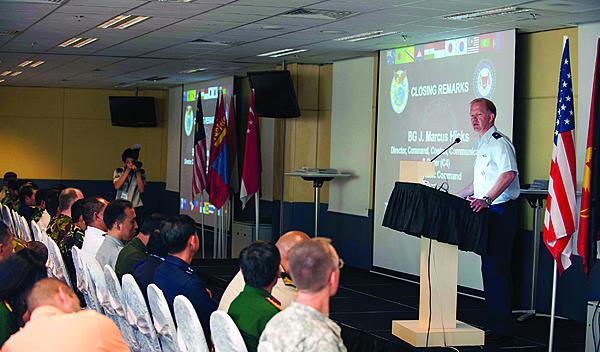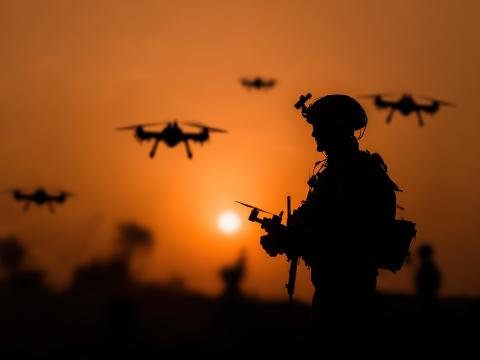Information Priorities in the Asia-Pacific
Cybersecurity remains the foremost concern for the man tasked with overseeing U.S. military communications technology in the Asia-Pacific area as the national defense strategy shifts focus to that region of the globe. New opportunities for technologies and programs are opening, but cyber issues continue to hold top billings in importance, and moves to shore up operations predate the recent official guidance.
A premier cyber center and the next phase of the Joint Information Environment are altering the technical landscape for U.S. forces.
Cybersecurity remains the foremost concern for the man tasked with overseeing U.S. military communications technology in the Asia-Pacific area as the national defense strategy shifts focus to that region of the globe. New opportunities for technologies and programs are opening, but cyber issues continue to hold top billings in importance, and moves to shore up operations predate the recent official guidance.
Brig. Gen. Mark Hicks, USAF, the director of command, control, communications and cyber, or J-6, for U.S. Pacific Command (PACOM), says a large amount of activity is underway in his organization, including the establishment of the Cyber Pacific (CYBERPAC) Joint Cyber Center, nominally directed by the general. “We’re the first COCOM [combatant command] to stand one up ... We’re kind of the poster child for it,” Gen. Hicks explains. Each COCOM is standing up separate ones, all of which report to U.S. Cyber Command’s Joint Operations Center, according to an official at PACOM. The initiative should create closer links among the parties and give more responsibility for cyberoperations to the commands.
CYBERPAC likely is the most developed of these centers in the U.S. Defense Department, and personnel have worked closely with higher authorities on how the structure of the initiative will work. “I view our cyber center as a node in the national cyber enterprise,” Gen. Hicks explains. The J-6 exercises cyber vigorously with all appropriate stakeholders to improve command and control ability. The general says that his first job is to ensure that the PACOM commander can command and control his forces in any contingency, including in a contested cyber environment. He shares that he has an expansive view of cyber, which runs through all facets of operations.
“I spend a lot of my personal energy working on cyber stuff,” Gen. Hicks says. Because cybersecurity continues to be such a sensitive subject across the military, details on many specific issues are classified, but in addition to finding technological tools, there is interest in nonmaterial solutions to challenges.
Cybersecurity constitutes a significant portion of the Joint Information Environment (JIE) Increment 2 that will be focused on the Pacific. Increment 1 is based in the European Command area of responsibility. The timing of the deployment decision is convenient for the PACOM J-6, which will have a substantial voice in the environment’s development. “We anticipate the ability to segment portions of the network into more secure enclaves,” Gen. Hicks explains. Measures to protect enclaves are under consideration, though specific technical solutions have not yet been determined fully.
Another key piece of the system is a solution for coalition communications. U.S. military involvement in the Asia-Pacific region is based largely on relationships with other countries in the region, and strengthening partnerships and alliances are key tenets of the PACOM mission. Direction from the Joint Staff to involve the Future Mission Network initiative—an information-sharing technology for international partners that grew out of the Afghan Mission Network—means the JIE Increment 2 will include a coalition network, according to Gen. Hicks.
Currently in the Asia-Pacific region, U.S. forces collaborate with different coalitions formed in response to events through various Combined Enterprise Regional Information Exchange System (CENTRIXS) enclaves. In exercises or operations involving partners without their own appropriate CENTRIXS units, U.S. personnel deploy with fly-away kits to set up connections temporarily, then bring them back home when the events end. “That is an inelegant solution in my opinion,” Gen. Hicks states. Through the JIE, the plan is to create affordable, scalable information-sharing networks quickly for whatever coalition needs them at a certain time. Then when missions end, the networks are disestablished and reconfigured for a different set of partners just as quickly. Already some National Security Agency cross-domain solutions have been approved for the initiative, but the building process rests with the military services.
“From my perspective, the president’s shift in strategy toward the Pacific hopefully gives us a little bit more priority,” Gen. Hicks says, which should allow the J-6 to have better say in what it provisions from the services. Because combatant commands except for U.S. Special Operations Command do not have their own budget authorities but are subsumed under the military branches’ budgets, Gen. Hicks’ directorate is both a victim of and advocate for the JIE Increment 2. “We’re in a position to make compelling arguments to do what we think is the right thing,” the general explains.
The lack of budget has implications beyond the JIE. In all avenues, officials must state strong cases for what they need and hope that groups with funding make programmatic decisions in their favor. “It’s a truly curious arrangement,” Gen. Hicks says. The J-6 is pulling from a decade of war in the Middle East to build its requirements. “We’re a beneficiary of their hard lessons,” the general explains. Coalition communications is the largest challenge to overcome and involves both technical and policy concerns.
Another issue relating to the Pacific JIE involves the difference in data center consolidation in that theater from others within the U.S. Defense Department. PACOM’s responsibility includes multiple land masses and ships at sea. Gen. Hicks says he argues the area is a disconnected, intermittently connected, low-bandwidth environment. Personnel on ships or islands could face natural or man-made situations that separate them from a cloud environment. The general says alternatives will be necessary at least on every land mass and likely in more localized areas as well. He believes PACOM still will meet efficiency goals, but the actual consolidation will not look the same as it does within the United States or Europe.
As attention continues to shift from the Middle East to the Asia-Pacific area, Gen. Hicks believes that many of the same challenges face communications personnel in both theaters despite some vastly different geographic, cultural and military features. “Obviously long-haul transport is a challenge in the Pacific,” he states. Priority for satellite communications is another issue along with the resiliency of cable set-ups on land masses vulnerable to weather, terrorists or even direct adversary action. “Not to mention, people dragging anchors across cables, which is one of our biggest concerns,” Gen. Hicks says. Both theaters challenge equipment and personnel with heat, humidity and dust, and both include active cyber adversaries.
Bringing coalition partners together in a secret network realm is another area of particular similarity. U.S. operations in Afghanistan are conducted in concert with multinational partners. Similarly, all of PACOM’s actions are performed with some type of international cooperation to try to maintain peace and security in its region, according to the general, who explains that his group will leverage lessons learned regarding U.S. Central Command’s networks to create coalition compatibility during the next build of information technology infrastructure.
Partnerships with military laboratories, federally funded research centers, military services, industry and others are helping the command’s J-6 develop the tools necessary for its future missions. Support from higher up the chain also has been forthcoming. “We have had a lot of visitation from senior departmental leaders trying to understand what we think the rebalance ought to be,” Gen. Hicks says. He believes that this interest is a good sign that everyone is trying to recognize what to do in the context of a decreasing budget departmentwide to ensure that the nation continues to maintain the same security levels it has today.
Domestic relationships are important especially because many of the challenges the organization faces will require policy solutions instead of or in addition to technical ones. One issue is communications security and how information is released to mission partners. In the wake of the WikiLeaks ordeal, the military has tightened information-release policies. Finding the right balance will be essential to correctly establishing the Pacific’s JIE iteration.
Evolving from its main thrusts to build military and other relationships with countries in the Asia-Pacific region, much of the command’s activity focuses on disaster response and humanitarian assistance—activities that require less concern over classified information than more sensitive types of operations. “I think we do a lot of work trying to change classification levels where we can,” Gen. Hicks says. Whether in the JIE or other means, the J-6 has to find the right security for the different situations.
Approximately one-third of the general’s effort goes toward multinational communications and interoperability, including cybersecurity that is framed within the humanitarian assistance/disaster response context. Collaboration on communications links provides opportunities for emerging allies and partners to build better relationships with the United States. It also can open access to certain countries as well as to help diffuse latent tensions or misunderstandings.
The J-6 recently made strides with Vietnam, which participated in the multinational exercise Pacific Endeavor this year. Gen. Hicks hopes to develop some bilateral engagements with that nation to improve not only communications interoperability but also basic military-to-military contacts. The general is optimistic about enhancing relations with India as well, saying he exchanged valuable dialogue with his counterparts there during his last trip. He additionally is pursuing contacts in China, a premier power in the region with ambiguous intentions toward U.S. interests. North Korea presents even more complexity. Discussions about issues in the J-6 arena, especially on nonkinetic situations, can help build relationships in a nonconfrontational way, and Gen. Hicks welcomes all countries in the Asia-Pacific area—subject to national policty guidelines—that are willing to participate in meaningful ways.
Cybersecurity again demonstrated its importance to the PACOM region during the 2012 Pacific Endeavor event, which included a module on the topic for the first time. Participants shared cyber best practices at an unclassified level. “I’m finding that cybersecurity is an increasingly popular menu item in our outreach portfolio,” Gen. Hicks says. The focus area is opening doors to new relationships.






Comments